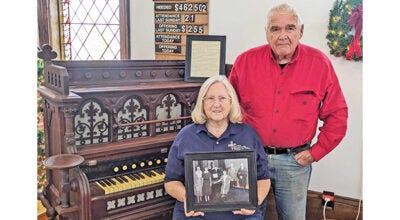Bringing resurgence of the cranberry
Published 1:24 pm Friday, September 10, 2010
- MISHAWAKA, Ind. -- Crystal L. Linde's determination to complete her high school education taking six classes in one year, even with a baby and working part-time, and also coming in with a smile, earned her the Outstanding Student Award at the Cassopolis Adult Education Graduation Thursday evening, held in Edison Lakes.
By TERRI GORDON
Off the Water
The DeGrandchamp family of South Haven is well-known in the local blueberry business and is becoming known in the cranberry business, too. Cranberry Harvest Days, on the first Saturday in October, is popular with visitors who take hay rides into the fields to watch the beds flooded and the berries gathered.
The story of how the family ended up in southwest Michigan growing berries traces back some 50 years, and involves Sister Ernestine and Grandma Claeys.
Agnes Claeys and her daughter, Beatrice DeGrandchamp trekked — innocently enough — from Detroit to Grand Rapids one August to visit Agnes’ cousin, Ernestine, a Dominican nun. When they arrived, they found the nuns preparing to go to South Haven, where a kind blueberry farmer allowed them to glean his fields each year at season’s end. The nuns picked and froze the berries to use in their cloister, and in the boarding school they ran. Agnes and Beatrice went along for the ride.
The farm was for sale at the time, and Ernestine feared losing future picking privileges.
“She didn’t want this good deal getting away,” DeGrandchamp recounted, “so she had it in the back of her mind that she’d get my dad to buy this farm.” When Agnes and Beatrice returned to Detroit, Sister Ernestine began her campaign.
“(She) would call my grandmother every week, and finally (Beatrice and Vincent) decided — just to settle her down — they’d come out and look at it,” DeGrandchamp said.
So, Agnes and her son-in-law, Vincent DeGrandchamp (Mike’s father), drove from Detroit to look at the South Haven farm. Something clicked. Vincent purchased the farm and moved west. All was well. The family had a blueberry farm, and the nuns still had their good deal.
“When I was little,” said DeGrandchamp, “they’d come down in buses — in their habits — and they’d pick blueberries and take them back to Grand Rapids. They said the nuns always prayed for a good crop so they could come and pick. It hasn’t been for quite a few years. We had a row — we called it my grandmother’s row — that the nuns would pick.”
Under Beatrice and Vincent, the farm grew from its original twelve acres to almost 200 acres. Thanks to a study Western Michigan University conducted some years ago, 40 of those acres are now devoted to cranberries. Their research showed that Michigan was the only state growing blueberries industry that wasn’t also producing cranberries. The two berries are in the same plant family and require similar growing conditions, so it is unusual to have one without the other.
To top it off, Michigan had had a thriving cranberry industry around the turn of the 20th century. Locally, cranberries were harvested in Grand Mere.
“Grand Mere was harvested commercially until about the Depression,” said DeGrandchamp. “It was strictly a fresh, seasonal fruit. There was no canning, there was no juice, so that went by the wayside.”
The research interested Vincent, so he took a tour through Wisconsin’s cranberry farms.
“Wisconsin is the largest producer in the country,” said DeGrandchamp. “Wisconsin has double the production of Massachusetts. They had room to expand. They didn’t have it in Massachusetts or New Jersey because of urbanization.”
The more Vincent DeGrandchamp learned the cons of cranberry growing, the more he wanted to do it.
Not far from the blueberry operation, Vincent bought land where sand had been excavated. Their work was already half done. The family moved in, finished the beds, and, in 1994, planted their first their first cranberries.
Unfortunately, Vincent never saw the fruits of his labors.
“He got a brain tumor and died the year we planted,” said DeGrandchamp.
But he proved his skeptics wrong. The first crop produced well enough they planted more. That grew well, so they planted still more. After 10 years, the beds are mature and the yield is high.
The children of Beatrice and Vincent now share the duties of running the farm. Bob manages the cranberry business; Joe is in charge of the blueberries. Their sister, Judy Johnson, runs the office and retail market and Mike oversees the nursery and greenhouses. During harvest season, however, they all come together and pitch in — Beatrice too, who guides folks through the market.
Cranberries and blueberries have become popular as medical studies found them high in antioxidants. They also fit into the “local food” movement. In fact, the two berries, along with Concord grapes, are native to North America, where natives used them to heal wounds, as well as for food and dyes.
For now, the DeGrandchamps are happy to be part of the berries’ resurgence.






